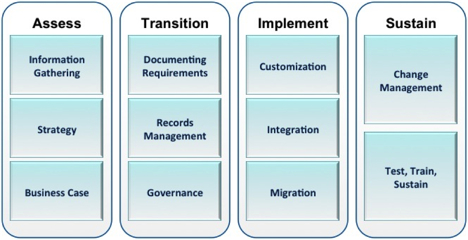Organizations are
facing the reality that electronic information is, or can be, a record and as
such, are now trying to address how they will manage this mounting mass. Many
organizations are turning to SharePoint as a solution to address this growing
challenge, and while the technology is good and may be well suited to address
some of an organization's document and records management requirements, the
technology alone is not enough to ensure compliance. In
a recent AIIM Industry Watch study, "SharePoint-strategies and experiences,"
we found that:
- 37% of organizations consider SharePoint to be
their first significant implementation of ECM. For smaller organizations, 52%
are first-timers, but this is also the case for 25% of over 5,000 employee
businesses. For those who already have ECM or RM systems, 41% have set
SharePoint as their collaboration tool but will retain their existing system
for document and records management. - 44% of respondents have rolled out SharePoint
across 10 or more geographical sites, with 14% covering over 100 geographical
sites and one third-of installations spanning more than one country. - 5% use SharePoint for collaboration between
project partners, and 18% use it to interact with customers. - One-third of respondents found their
SharePoint project took longer than expected although cost overruns were
reported less often. The biggest project issues were management of process change and user resistance to new interfaces - A third of implementing organizations have no
plans as to where and where not to use SharePoint, suggesting a lack of
management direction. - 26% reported that the IT department is driving
the project with no input from information management professionals. - Team site sprawl, with no policy on ownership
and end-of-life, is an issue for a quarter of users. - 58% of active users do have a policy on site
ownership and responsibilities, but only 19% on end-of-life.
In addition, the research showed that "governance is sadly
lacking in the majority of installations with little thought given to
e-discovery, retention policies and, most of all, classification schemes and
metadata standards."
When considering
SharePoint or any technology to address document and records management, focus
must also be given to those elements that support overall compliance,
positioning technology as a tool along with governance, well-designed and documented processes, change management and continuous improvement to monitor
and adjust your environment as needed. Technology alone is not the complete
answer so neither should SharePoint be considered the complete answer. Questions you must ask are:
Do you have an established taxonomic structure?
What is your metadata strategy?
Is your security aligned properly with
your information architecture for managing both physical and electronic
information?
When did you last asses your recovery
plan, and have you identified and addressed vital records recovery?
Are your retention policies in line
with regulatory guidelines at all levels (multi-national companies will have
varying requirements)?
All of these are
critical to the establishment and success of an ERM environment. All of these elements
must be carefully orchestrated to deliver the greatest benefit and support
highest levels of compliance possible. SharePoint is a good technology and can
work well as part of your overall ERM toolkit, but is it really enough alone? In my view, the answer is no. There is a whole lot more to a SharePoint
implementation than the technology, and this is where many organizations fall
short. In order to implement and establish a solid SharePoint environment, it
must be understood that SharePoint itself is a tool rather than a solution,
which means that organizations planning to or currently using SharePoint need
to treat it as any other application and fully understand the purpose of its
use in order to be successful. There are four key areas that need to be
addressed in relation to implementing SharePoint. These are Assess, Transition,
Implement and Sustain.

As you can see, there
is a lot more to implementing SharePoint than most expect if it is to be
successful. If you are not sure where to begin, seek professional guidance or
training and take the appropriate steps now to ensure your future.
What say you? How are
you, or have you managed, implementing SharePoint? Do you have a story to tell? I
want to hear from you.
BOB LARRIVEE
[blarrivee@aiim.org] is director
and industry analyst for AIIM. Mr. Larrivee is an internationally
recognized lecturer with over 25 years of experience in the
application of advanced technologies and process improvement.













